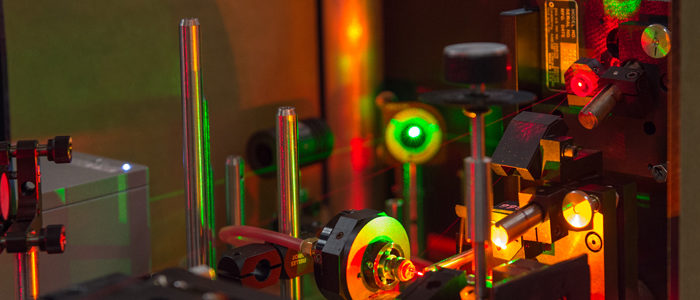Research in the group focuses on the use of coherent optical interactions to study, control, and manipulate the quantum properties of semiconductor heterostructures. Over the past few years, the group has been able to demonstrate astonishing atom-like phenomena in a complex condensed matter system. This has opened up the possibility of using such semiconductor heterostructures in schemes of making a scalable quantum computer. Recently we have also begun work on doing spectroscopy using special light beams which carry orbital angular momentum. We encourage you to explore our projects by clicking on the links above. For any technical questions or inquiries about opportunities in the group, feel free to contact any of the Graduate students or Prof Steel himself.
Continuous Wave Spectroscopy
Quantum dots are typically formed from large groupings of atoms and thus may be expected to have appreciable many-body behavior under intense optical excitation. Nonetheless, they are known to exhibit discrete energy levels due to quantum confinement effects. We show that, like single-atom or single-molecule two- and three-level quantum systems, single semiconductor quantum dots can also exhibit interference phenomena when driven simultaneously by two optical fields. Probe absorption spectra are obtained that exhibit Autler-Townes splitting when the optical fields drive coupled transitions and complex Mollow-related structure, including gain without population inversion, when they drive the same transition.
Quantum computation requires a continuous supply of rapidly initialized qubits for quantum error correction. We have demonstrated fast spin state initialization with near unity efficiency in a singly charged quantum dot by optically cooling an electron spin. The electron spin is successfully cooled from 5 to 0.06 K at a magnetic field of 0.88 T. The spin cooling rate is of order 109/s , determined by the spontaneous decay rate of the excited state.
When a magnetic field is applied to the dot in a direction transverse to the growth direction, the electron spin states (spin up and spin down) are split in energy by the Zeeman splitting. Using two lasers of different wavelength, these two electron states can be coupled to the same excited state. In this three-level lambda (L) energy structure, the laser coherence interacts with the electron spin coherence allowing us to create and measure the resulting electron spin superposition (the ‘dark state’). The specific superposition state is controlled by the ratio of pump to probe laser power and the electron spin coherence time can be measured via the appearance of a pronounced dip in the probe absorption spectrum.
Recent efforts have been made to protect the coherence of spins in quantum dots by suppressing the nuclear spin fluctuations. We are able to suppresses the nuclear field fluctuations in a singly charged quantum dot to well below the thermal value, as shown by an enhancement of the single electron spin dephasing time T2*, which we measure using coherent dark-state spectroscopy. The suppression of nuclear fluctuations is found to result from a hole-spin assisted dynamic nuclear spin polarization feedback process, where the stable value of the nuclear field is determined only by the laser frequencies at fixed laser powers. This nuclear field locking is further demonstrated in a three-laser measurement, indicating a possible enhancement of the electron spin T2* by a factor of several hundred. This is a simple and powerful method of enhancing the electron spin coherence time without use of ‘spin echo’-type techniques. We expect that our results will enable the reproducible preparation of the nuclear spin environment for repetitive control and measurement of a single spin with minimal statistical broadening.
Time Domain Studies
Indium Arsenide self-assembled quantum dots are a major research focus of our group. The electron spin in a single quantum dot is a promising qubit for quantum computing because of the long spin coherence time. Single dot studies in self-assembled dots are challenging due to extremely low signal levels and require the use of phase sensitive techniques to eliminate noise. An ongoing effort has been to use laser pulses to manipulate the electron spin. Recent achievements include electron manipulation and readout using picosecond laser pulses (Kim, APL, 2010) and arbitrary rotation of the electron spin using a combination of a magnetic field and optical pulses (Kim, PRL, 2010). We continue to improve our ability to coherently control the state of the electron with the eventual goal of scaling InAs quantum dots to a multi-qubit system

